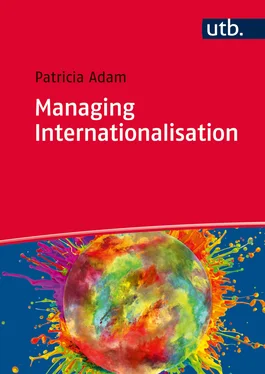| EFQM Fundamental Concepts of Excellence |
| Figure 1-8 |
EFQM Fundamental Concepts - Definitions and Best Practices |
| Figure 1-9 |
The EFQM Excellence Model Framework 2013 |
| Figure 1-10 |
Definitions of the EFQM Enabler Criteria |
| Figure 1-11 |
Definitions of the EFQM Results Criteria |
| Figure 1-12 |
Exemplary Levels of the EFQM Excellence Model |
| Figure 1-13 |
Exemplary Red Threads Through the EFQM Excellence Model |
| Figure 1-14 |
The EFQM RADAR® Logic |
| Figure 1-15 |
The Internationalisation Process |
| Figure 2-1 |
Concept Map “Cross-Cultural Competence” |
| Figure 2-2 |
The Cultural Iceberg |
| Figure 2-3 |
Developmental Model of Intercultural Sensitivity |
| Figure 2-4 |
Three Levels of Uniqueness in Human Mental Programming |
| Figure 2-5 |
The Hofstede Onion - Manifestations of Culture |
| Figure 2-6 |
Hofstede’s Five Dimensions as a Control Panel |
| Figure 2-7 |
Key Differences between Cultures with Small and Large PDI |
| Figure 2-8 |
Selected PDI Country Ratings |
| Figure 2-9 |
PDI Values for Six Categories of Occupations |
| Figure 2-10 |
Key Differences between Cultures with Small and Large IND |
| Figure 2-11 |
Selected IND Country Ratings |
| Figure 2-12 |
Key Differences between Feminine and Masculine Cultures |
| Figure 2-13 |
Selected Country Scores for MAS |
| Figure 2-14 |
Key Differences between Cultures with Weak and Strong UAI |
| Figure 2-15 |
Selected Country Scores for UAI |
| Figure 2-16 |
Key Differences between Cultures with high or low LTO |
| Figure 2-17 |
Selected Country Scores for LTO (WVS) |
| Figure 2-18 |
Cultural Cluster of Germanic Countries |
| Figure 2-19 |
Country Clusters Based on the Four Original Hofstede Dimensions |
| Figure 2-20 |
Key Differences between Indulgent and Restrained Cultures |
| Figure 2-21 |
Selected Country Scores for IVR |
| Figure 2-22 |
Cultural differences Expressed as Normal Distributions |
| Figure 2-23 |
Percentages Opting for Telling the Truth |
| Figure 2-24 |
Typical Characteristics of Universalistic vs. Particularistic Cultures |
| Figure 2-25 |
Percentages Opting for Individual Freedom |
| Figure 2-26 |
Percentages Opting for Not Expressing Emotions Overtly |
| Figure 2-27 |
Percentages Not Painting the House |
| Figure 2-28 |
Percentages Opting for Getting Things Done |
| Figure 2-29 |
Circle Diagrams for Past, Present and Future |
| Figure 2-30 |
Differences of Past, Present and Future Orientation |
| Figure 2-31 |
Average Time Horizon |
| Figure 2-32 |
Percentages Agreeing to What Happens to Me is My Own Doing |
| Figure 2-33 |
The Three-Step-Approach |
| Figure 2-34 |
Reconciling Globalism and Localism |
| Figure 2-35 |
GLOBE - Nine Cultural Dimensions |
| Figure 2-36 |
GLOBE - Country Clusters |
| Figure 3-1 |
Concept Map “Leading the Internationalisation Process” |
| Figure 3-2 |
Aspects Influencing Leadership Success |
| Figure 3-3 |
One-Dimensional Behavioural Leadership Theories Based on Participation |
| Figure 3-4 |
Two-Dimensional Behavioural Leadership Theories |
| Figure 3-5 |
Contingency Models |
| Figure 3-6 |
Relationship-Based Leadership Approaches |
| Figure 3-7 |
The Big Five Personality Factors and Their Facets |
| Figure 3-8 |
EFQM Criterion 1 “Leadership” and Its Criterion Parts |
| Figure 3-9 |
EFQM Criterion Part 1a and Its Guidance Points |
| Figure 3-10 |
Corruption Risks Within Domains of Corporate Activities |
| Figure 3-11 |
Percentages Opting for Blaming an Individual |
| Figure 3-12 |
GLOBE - Six Global Leader Behaviours |
| Figure 3-13 |
JOHARI Window and the Importance of Feedback |
| Figure 3-14 |
360° Feedback |
| Figure 3-15 |
Trompenaars and Hampden-Turner’s Four Corporate Cultures |
| Figure 3-16 |
Preferences for Corporate Cultures in Different Countries |
| Figure 3-17 |
Dimensions of Diversity |
| Figure 3-18 |
Lewin’s Three Steps of Change |
| Figure 3-19 |
Eight Steps for Leading Change |
| Figure 4-1 |
Concept Map “Defining and Delivering an International Strategy” |
| Figure 4-2 |
Strategy Development and Implementation – Overview |
| Figure 4-3 |
EFQM Criterion 2 “Strategy” and Its Criterion Parts |
| Figure 4-4 |
Environmental Scan |
| Figure 4-5 |
Generalised Stakeholder Map |
| Figure 4-6 |
Industry Analysis Based on Porter’s Five Forces (Expanded Model) |
| Figure 4-7 |
Overview Competitor Analysis |
| Figure 4-8 |
Selected PESTEL Variables |
| Figure 4-9 |
Sources for Analysing Countries and Markets |
| Figure 4-10 |
The Global Competitiveness Index Framework |
| Figure 4-11 |
Sample Steps of a Scenario Analysis |
| Figure 4-12 |
Issues Priority Matrix for Key Driver Selection |
| Figure 4-13 |
Levels of Competence Sustainability |
| Figure 4-14 |
Organisational Analysis Based on Porter’s Value Chain |
| Figure 4-15 |
SWOT Analysis |
| Figure 4-16 |
Great Jeans’ SWOT Matrix |
| Figure 4-17 |
Choice of Location and Market |
| Figure 4-18 |
The Growth-Share Matrix (BCG-Matrix) |
| Figure 4-19 |
Different Strategy Levels |
| Figure 4-20 |
The Nine Building Blocks of the Business Model Canvas |
| Figure 4-21 |
Sketch of Great Jeans Canvas (Basic Model) |
| Figure 4-22 |
Epicentres of Business Model Innovation |
| Figure 4-23 |
Great Jeans’ Innovative Business Model |
| Figure 4-24 |
Porter’s Three Generic Strategies |
| Figure 4-25 |
A Selection of Business Models |
| Figure 4-26 |
Patterns of Business Models on Business Model Canvas |
| Figure 4-27 |
Business Model Development Process |
| Figure 4-28 |
From Purpose to Strategy Implementation |
| Figure 5-1 |
Concept Map “Deploying Strategy through People” |
| Figure 5-2 |
The Human Resource Management Process |
| Figure 5-3 |
Labour Regulation Aspects in International HRM |
| Figure 5-4 |
EFQM Criterion 3 “People” and Its Criterion Parts |
| Figure 5-5 |
Four Generic HRM Strategies |
| Figure 5-6 |
Internationalisation Strategies and HRM Policies |
| Figure 5-7 |
The Optimal Global Assignment Process |
| Figure 5-8 |
Phases in Cultural Adjustment – Customised W-Curve |
| Figure 5-9 |
People Portfolios |
| Figure 5-10 |
Obtaining Feedback |
| Figure 5-11 |
KODE® Enhanced Atlas of Competencies |
| Figure 5-12 |
KODE®X Process |
| Figure 5-13 |
Levels of Hypercultural Competence |
| Figure 5-14 |
Drivers of Motivation Processes |
| Figure 5-15 |
Kehr’s 3K-Model of Work Motivation |
| Figure 5-16 |
Job Characteristics Model |
| Figure 5-17 |
Heckhausen’s Model of Achievement Motivation |
| Figure 5-18 |
Attribution Characteristics and Their Influence on Motivation |
| Figure 5-19 |
Reconciling the Reward Dilemma through Co-Opetition |
| Figure 5-20 |
Team Empowerment Dilemma |
| Figure 5-21 |
Control & Autonomy Dilemma |
| Figure 5-22 |
Multiple Dimensions of Inter-Organisational Communication |
| Figure 5-23 |
The Communication Tool Cube for Internal Communication |
| Figure 5-24 |
Characteristics of Low and High Context Communication |
| Figure 5-25 |
Work/Life Balance - Causes, Nature and Consequences |
| Figure 6-1 |
Concept Map “Managing International Partners and Resources” |
| Figure 6-2 |
EFQM Criterion 4 “Partnerships & Resources” and Its Criterion Parts |
| Figure 6-3 |
Overview of Foreign Operation Modes |
| Figure 6-4 |
Characteristics of Selected Foreign Operation Modes |
| Figure 6-5 |
Relevant Fits in Strategic Alliances |
| Figure 6-6 |
Pitfalls of Strategic Alliances |
| Figure 6-7 |
Typical Forms of Licensing Agreements |
| Figure 6-8 |
Approaches to Joint Venture Management |
| Figure 6-9 |
Chosen Perspectives on M&A Strategies |
| Figure 6-10 |
Synergies and Barriers of M&A Projects |
| Figure 6-11 |
Varieties of Acculturation in M&A Processes |
| Figure 6-12 |
Guiding Matrix for Make-or-Buy Decisions |
| Figure 6-13 |
Organisational Financial Management - Overview |
| Figure 6-14 |
The Three-Lines-of-Defence Model |
| Figure 6-15 |
ISO High Level Structure for Management Systems |
| Figure 6-16 |
Compliance Management Process Based on ISO 19600:2014 |
| Figure 6-17 |
Risk Management Process Based on ISO 31000:2009 |
| Figure 6-18 |
Sample Risk Map |
| Figure 6-19 |
Organisational Cultures and Risk Orientation |
| Figure 6-20 |
Knowledge Dimensions |
| Figure 6-21 |
Organisational Learning Cultures |
| Figure 6-22 |
Organisational Knowledge Management Process and Activities |
| Figure 6-23 |
Pyramid of Organisational Information Systems |
| Figure 7-1 |
Concept Map “Managing Processes and Products Globally” |
| Figure 7-2 |
EFQM Criterion 5 “Processes, Products and Services” and Its Criterion Parts |
| Figure 7-3 |
From Function Orientation to Process Orientation |
| Figure 7-4 |
Aligning Process Management and Business Strategies |
| Figure 7-5 |
Overview of Business Process Management |
| Figure 7-6 |
Sample Process Diagrams |
| Figure 7-7 |
Example of ARIS Items and Event-Driven Process Chain |
| Figure 7-8 |
BPM Process Levels in a Sample Process Map |
| Figure 7-9 |
The ISO 9000 Family of Quality Management Standards |
| Figure 7-10 |
Mapping ISO/DIS 9001:2014 on the EFQM Model |
| Figure 7-11 |
Structure of Quality Requirements for Value Creating Processes |
| Figure 7-12 |
How (Not) To Conduct an Optimal Product Design Process |
| Figure 7-13 |
Simple Supply Chain of Great Jeans |
| Figure 7-14 |
A Global View on Great Jeans’ Supply Chain |
| Figure 7-15 |
Customer Relationship Management Based on the IDIC Approach |
| Figure 8-1 |
Concept Map “Monitoring and Achieving Balanced Results” |
| Figure 8-2 |
EFQM Result Criteria and Their Criterion Parts |
| Figure 8-3 |
The Allocation of Results |
| Figure 8-4 |
Kaplan & Norton’s Balanced Scorecard |
| Figure 8-5 |
Balanced Scorecards Aligned Across All Organisational Levels |
| Figure 8-6 |
Mapping the BSC Concept on the EFQM Excellence Model |
| Figure 8-7 |
Poorly Designed Dashboard |
| Figure 8-8 |
Adequate Dashboard for Great Jeans |
| Figure 9-1 |
Concept Map “Assessing the Organisation’s Management Model” |
| Figure 9-2 |
Drucker’s Five Most Important Questions Asked about an Organisation |
| Figure 9-3 |
Basic Self-Assessment Process |
| Figure 9-4 |
Classification of Different Self-Assessment Tools |
| Figure 9-5 |
Self-Assessment Matrix of ISO 9004:2009 – Sample Element |
| Figure 9-6 |
Exemplary Award Simulation Process |
| Figure 9-7 |
RADAR Elements for the Analysis of Enablers |
| Figure 9-8 |
Composition of the Enabler Matrix |
| Figure 9-9 |
RADAR Elements for the Analysis of Results |
| Figure 9-10 |
Criteria Weightings of the EFQM Excellence Model 2013 |
| Figure 9-11 |
EFQM Recognition Scheme |
| Figure 9-12 |
Global Distribution of Awards Using the EFQM or Baldrige Model |
| Figure 9-13 |
Overview of EEA and MBNQA Award Categories |
| 1 |
Introduction and Overview Strategic International Management |
Welcome to the fascinating world of international organisations. This book will introduce the internationalisation process in its rich diversity and sometimes astonishing complexity. Each section is preceded by learning objectives that explain the knowledge gained in reading through the subsequent pages. The objectives for section one are presented here:
Читать дальше












